The prime goal of any prosthodontic treatment is to provide the patient with precisely fitting restorations or prosthesis [1]. For accurate replication of tooth preparations and to register their precise arch position we require impression material with minimal distortion. Various impression materials have been advocated for making the impressions in fabricating fixed partial dental prosthesis. Polyvinyl siloxane impression materials also known as addition silicones have been popularized recently. Based on literature review, the accuracy and dimensional stability of elastomeric impression materials have been the subjected to numerous investigations [2].
The American Dental Association (ADA) Specification No. 19 identifies these materials as “non aqueous elastomeric dental impression materials”. Out of different elastomers, polyvinyl siloxane or addition silicones have demonstrated superior physical properties and have attained clinical success. Polyvinyl siloxane posses minimal permanent deformation values, excellent dimensional stability and produce accurate stone dies when compared to other impression materials [3–8]. They have a very low polymerisation shrinkage and produce no by-products .The dimensional accuracy of elastomeric impression materials is expressed in terms of its ability to overcome distortion while it is setting [9–11].
The accuracy of polyvinyl siloxane is determined by various factors like the technique used, the material used and the bulk of the material contained in the impression tray [12–15]. The custom trays are recommended to reduce the bulk of the material and to ensure the uniform thickness of the material so as to minimise the polymerisation shrinkage. A custom tray is desirable because it permits the placing of suitable stops, to ensure that the impression sits correctly and also considerably less material is required.
Various techniques have been employed using addition silicones since 3-4 decades, the most widely used are the putty wash, putty reline and custom tray technique [1]. Based on the literature study, both stock and customised trays were tried but the latter is more advantageous [8,16].The custom trays can be used with heavy body, light body as well as medium body and light body combinations called as multi mix techniques [3]. Dimensional accuracy is not only affected by the technique but also by the different spacer designs. This may also have an impact on the inter-abutment distance due to the excess polymerisation shrinkage especially with monophasic materials [17,18].
Previous studies have reported undesirable dimensional changes and inaccuracies of the stone casts due to excessive and uneven thickness of the elastomeric impression material and also due to different impression techniques [19–23]. Though multiple research on polyvinyl siloxanes have focused on their properties only little information is available regarding the effect of techniques and tray selection on accuracy.
An attempt has been made in this study to evaluate the dimensional accuracy of additional silicones by comparing multimix and monophasic techniques as well as effect of bulk of the material which is controlled by spacer design. By measuring the linear changes in the Inter preparation distance dimensional accuracy of the impressions were determined.
Materials and Methods
A stainless steel die was made to serve as a model simulating a three unit fixed partial denture replacing the mandibular first molar. The abutments had a uniform 6°angle of convergence and were firmly attached to the platform and therefore remains immobilised during impression making [Table/Fig-1a,1b]. The reference lines in the shape of ‘+’, which were inscribed on the occlusal surfaces of the two abutments . The intersection point of the reference lines is used for assessing the linear change in the inter preparation distance with a travelling microscope.
Pictorial representation of stainless steel die model depicting all the dimensions of three unit bridge
Distance between abutment preparation–10.5 mm,
Gingival width of molar dies–10.5 mm,
Gingival width of premolar dies–7.5 mm,
Occluso gingival height of the dies–9.5 mm
Platform thickness–5 mm,
Distance between reorientation grooves & abutments–7 mm,
Angle of convergence of abutments–6 degree
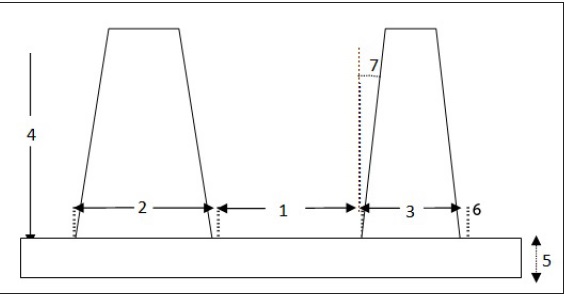
The stainless steel die model representing a three unit bridge
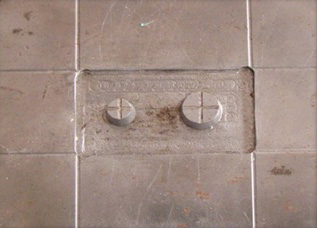
The impression material used is the addition silicone of two different consistencies i.e. medium body and light body (Dentsply). Two types of spacers were made with a uniform thickness of 2 mm. The spacer one was fabricated over the abutment preparations without going into the edentulous space [Table/Fig-2a]. The spacer two was adapted in such a way that it is uniformly 2mm short of the edentulous area [Table/Fig-2b].
Spacer 1 without covering edentulous area
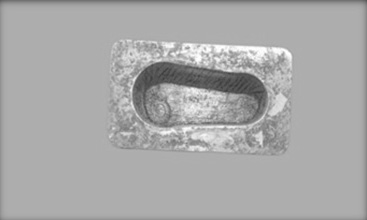
Spacer 2 covering the edentulous area
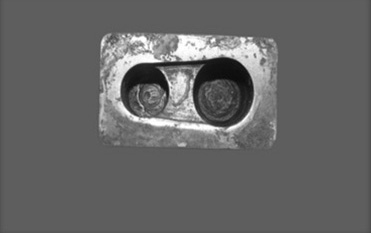
For impression making two different techniques were used-Multimix technique and Monophasic technique. In Multimix technique the medium body was used as tray material and light body as the wash material. Both the light body and medium body consistencies were mixed simultaneously using auto mixing dispensers to ensure that the setting time is similar for adequate bonding and removal from the die [Table/Fig-3]. For Monophasic technique, both the tray and syringe materials were from same consistency [Table/Fig-4]. The tray was seated over the die and proper seating was verified by the orientation grooves on the master model. These orientation grooves standardized the pressure that orient the tray on proper position with uniform pressure while placing the tray over the die. The impressions were taken out after slightly longer time as recommended by the manufacturer. The setting time was increased according to manufacturer’s recommendations by keeping material in the refrigerator. All impressions were stored at room temperature for 24 hours before being poured and inspected for voids and irregularities if they were seen the impressions were repeated. A total 80 samples were obtained from the impressions made 40 for each spacer design technique.
Impressions taken by multimix technique
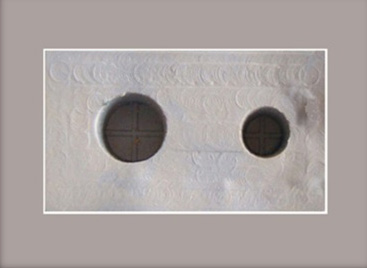
Impressions taken by monophasic technique
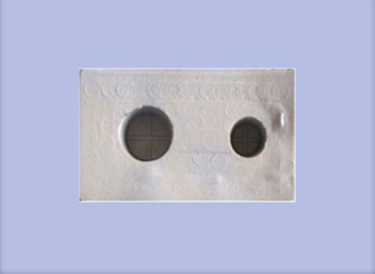
All the impressions obtained were boxed to make the bases flat using the modelling wax. The die stone was mixed with a powder water ratio of 100:23 as recommended by the manufacturer.
The powder was weighed on electronic weighing machine and water was measured in graduated dispensing cylinder. The powder was added to the water and allowed to wet for 10s before the mixture was hand spatulated with a flat ended stiff spatula for 10s. The mixture was poured every time in each of the impression in the small increments with a small instrument. The impression was kept on the vibrator to avoid the risk of air entrapment. The mixture was poured till the boxed tray was completely filled. The gypsum casts [Table/Fig-5,6] were retrieved after 24h from the impressions and were air dried for 48h before testing.
The casts retrieved by both the techniques and spacer designs

Assessment of accuracy
The casts generated were used to assess the accuracy of the reference lines of ‘+’ shapes were used to measure the Inter preparation distance using a travelling microscope sensitive to 0.001cm. Each measurement was repeated thrice on the stone casts and the mean was recorded and compared with the mean distance recorded on the master die. To eliminate the individual variability, all samples were measured by the same individual. The results obtained were tabulated and analysed statistically.
Results
This study was conducted to quantitatively evaluate the dimensional accuracy of addition silicone materials by measuring the linear change in the inter preparation distance between the abutments. The accuracy was assessed from the die stone (type IV) casts made from impressions of the stainless steel master model. The reference lines on the occlusal surfaces of the abutment teeth were used for measuring the inter preparation distance between the abutments. A travelling microscope was used for the measurements. A total of 80 impressions were made. Die stone casts were retrieved after 24h. Each recovered cast was measured thrice and average mean value was recorded.
The Alphanumeric Coding
The groups under the study were coded alphanumerically:
The Multimix technique was coded as MM and the Monophasic technique was coded as MP
Spacer designs were coded as 1 & 2
Master Die Measurements
A - MM1 Multimix technique with spacer design 1
B - MP1 Monophasic technique with spacer design 1
C - MM2 Multimix technique with spacer design 2
D - MP2 Monophasic technique with spacer design 2
The inter preparation distance on the master die was measured thrice and a mean was recorded as the standard value. Inter preparation distance - 18.38 mm.
The mean and standard deviation was calculated for each group i.e. spacer designs & techniques were evaluated statistically. The paired t-test was applied to evaluate the significant differences between the materials and the spacer designs. The results were tabulated and analysed using SPSS software. The cast obtained from both techniques and spacer designs were statistically significant to each other. A significant difference was noted statistically between the two techniques (p<0.05) [Table/Fig-7]. The significant difference is more with the monophasic technique in comparison of multimix technique when compared to the master die. Similarly a significant difference between the two spacer designs was observed (p<0.05) [Table/Fig-8]. However, statistically the significant difference is more with the spacer design that is not covering the edentulous area in comparison of the spacer design that is covering the edentulous area when compared with the master die.
Mean of the interpreparation distance between two impression techniques i.e. multimix and monophasic technique (N=40)
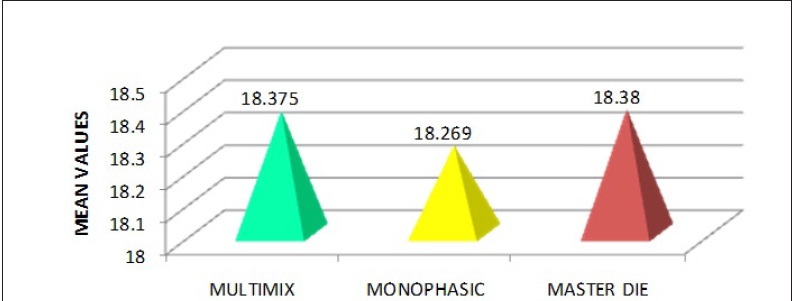
Mean of the interpreparation distance between two spacer designs i.e. spacer 1 and spacer 2 (N=40)
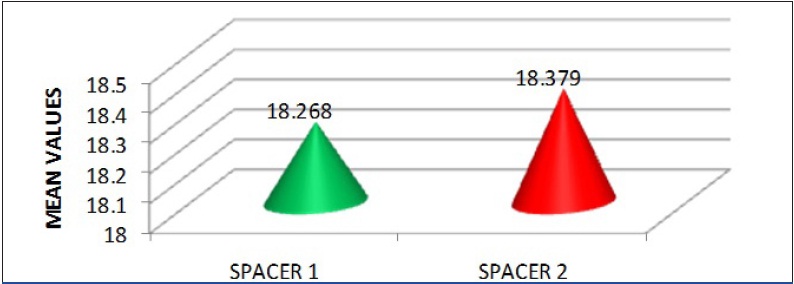
Discussion
Making an impression represents a crucial step in processing and fitting dental prosthesis. For that reason, the quality of the impression is decisive for final fitting accuracy and consequently for the success of the dental reconstruction. Interest has grown in a new group of impression materials called addition silicones since they have shown to be accurate and dimensionally stable [24–26]. Tray selection is the first step to start with the impression making. A custom tray is required to minimise the effects of polymerization shrinkage, loss of reaction by-products and deformation associated with tray seating and removal [27–29]. The next step involves the selection and use of the preferred viscosity for making an impression. This includes a multiple mix or dual viscosity technique or monophasic technique [30].
The basic data obtained in this study shows, when the two tray designs were compared. The percentage change in polymerisation shrinkage in the inter preparation distance was calculated [31].
The difference between the mean of stone model and the mean of master model multiplied by 100 was expressed as percentage deviation from master model for both the parameters impression technique and spacer design.
Percentage of deviation = mean of stone model-mean of master model / mean of master model multiplied by 100
The percentage of deviation for spacer 1 is 0.600% and for spacer 2 is 0.001%.This deviation is because of more polymerisation shrinkage in spacer one as the thickness of material was more between the abutments [32,33]. The polymerisation shrinkage values indicate the low value of polymerisation contraction obtained with the medium body materials as compared with light bodied products because of the difference in concentration of inert fillers [25]. This variation occurred because of more polymerisation shrinkage in spacer design one as the thickness of material was more between the abutments. An increase in bulk of impression material inevitably results in a greater inaccuracy of the impression because of more thermal contraction [33,34]. Hung et al., also concluded the same that the increased amount of bulk increases the polymerization shrinkage and recommended spacer design 2 [35]. De Araujo et al., also concluded that the increase in bulk of impression material inevitably results in a greater inaccuracy of the sion [32]. However, results of this study were well within the clinically acceptable limits as mentioned in the literature and in consensus with the studies by the authors mentioned above [34,36].
When multimix technique using medium body and light body addition silicones were compared with monophasic single mix technique, the multimix technique was more accurate than the monophasic single mix technique [1,25,34–36]. The percentage of deviation for multimix techniques for interpreparation distance was 0.008% and for monophasic was 0.599%. The similar change in accuracy of monophasic material was also reported by Tjan et al., [29] and from the clinical perspective, these deviations in the inter preparation distance from master model are not of sufficient magnitude to cause difficulty, when the inherent elasticity of the relevant intraoral tissues is considered.
Craig stated that impression materials have improved to such an extent that accuracy may be controlled more with technique than by material itself [1,37–39]. The polymerisation shrinkage values indicate the low value of polymerization contraction obtained with the medium body materials as compared with light bodied products because of the difference in concentration of inert fillers [35].
Henry et al., also concluded that multiple mix is better than monophasic technique [37]. Richard J Schnell summarized that double mix procedure not only increases the initial accuracy of the impression, but also reduces the distortion during storage. The superiority of the multiple mix over single mix is probably due to several factors [40–43].
When the partially set material in the tray is seated, it will displace much of the injected material. This tray material has undergone a greater amount of curing shrinkage and thus results in less subsequent change in the critical regions of the impression [44–47]. Likewise the tray material compresses the injected material and thus eliminates many of the air bubbles trapped within the material and between the material and the tooth.
From the clinical perspective, these deviations in the inter preparation distance from the master model are not of sufficient magnitude to cause difficulty when the inherent elasticity of the relevant intraoral tissues is considered [33,48].
In this study, since all the procedures were standardised and all groups received the same controlled treatments, the differences in the dimensional accuracy among the test groups were assumed to be attributable to the techniques, materials and the spacer design. This study was limited to only two consistencies (medium body & light body) of polyvinyl siloxanes. Further research with different consistencies of polyvinyl siloxanes is needed.
Limitations
In this study distances were measured only at the occlusal level and restricted to the horizontal plane only. The measurements were made only for a three unit fixed partial denture situation , which may not hold true for a long span fixed partial denture or cross arch dimensional accuracy. Though every effort was made to simulate the oral conditions, the experiments could not be performed identical to oral conditions.
Conclusion
The spacer which was closely adapted to the abutments and the edentulous area rather than bridging over the abutments resulted in maximum dimensional accuracy.
Among the addition silicones the multimix technique was more dimensionally accurate than the monophasic material.
The most accurate combination was the multimix technique using addition silicone with the spacer closely adapted to the edentulous area.